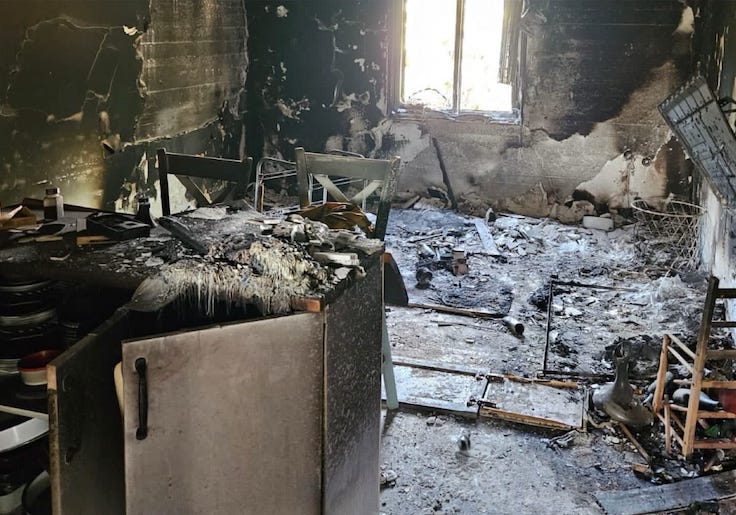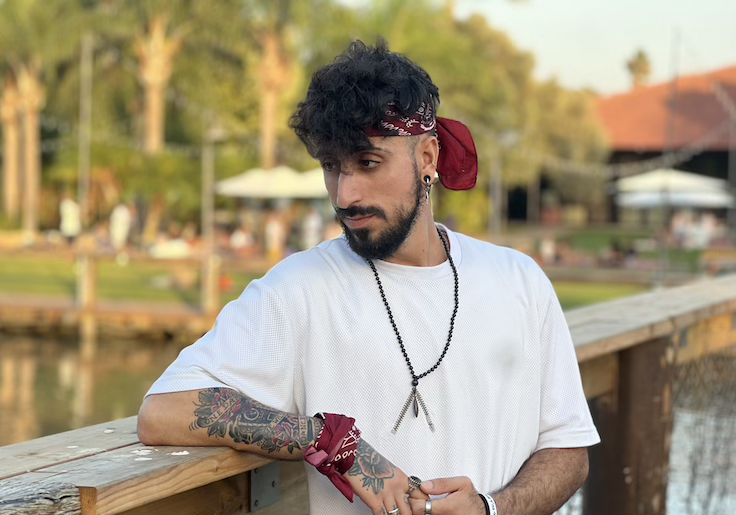EILAT, Israel—Eran Smilansky, a 28-year-old potato farmer, watched Gazan children go from house to house in his kibbutz on Oct. 7. Hamas terrorists followed. The boys laughed as the gunmen shot or dragged away Israeli families.
"They were like young, young kids," said Smilansky, who defended his home from terrorists for more than six hours that day. "They were going in front of the terrorists, laughing with their friends and looking very calm. I remember thinking, What the fuck?"
Smilansky was one of a dozen survivors of the Nir Oz massacre who told the Washington Free Beacon they witnessed boys or women from the Gaza Strip looting the kibbutz, helping the armed terrorists, and apparently enjoying themselves. The youngest children were around 10 years old, according to several of the survivors, one of whom provided photographs of some of the women and children he saw. The survivors spoke at a hotel in Eilat, Israel's Red Sea resort town, where most of them have been temporarily relocated.
While the involvement of Gazan children and women in Hamas's Oct. 7 rampage through southern Israel is not widely understood, evidence exists in the public domain. An online video of a 12-year-old Israeli boy's abduction from Nir Oz, Israel, appears to show a Gazan boy of about the same age accompanying the kidnappers. Boys were among the mob of Gazans recorded crossing into Israel after Hamas terrorists breached the border. And Hamas-linked Associated Press stringer photographed a Gazan boy entering Kfar Aza, another kibbutz near Gaza, and about 15 miles north of Nir Oz.
Hamas has used its nearly two decades of rule over Gaza to weaponize a generation of Palestinians against the Jewish state, according to analysts. Hundreds of ordinary Gazans, including teenagers, joined in Hamas's assault, during which terrorists killed some 1,200 people and took some 240 hostages, the Free Beacon previously reported.
"Hamas directed the education system, the media, and the religious institutions to brainwash children, who make up half of Gaza's 2.2-million-person population," Michael Milshtein, the head of the Palestinian Studies Forum at the Moshe Dayan Center of Tel Aviv University, told the Free Beacon. "Israelis got their first up-close look at this Palestinian Gen Z on Oct. 7."

Like most of the Nir Oz survivors, Eyal Barad and his family hid in the safe room of their house from about 6:30 a.m. until the Israeli military evacuated them 12 or so hours later. But Barad, an engineer, had a rare view of the outside world thanks to a speed camera he had recently set up to bust his neighbors for driving on the sidewalk.
On the camera's livestream, Barad watched three types of Gazans pass by his house: uniformed Hamas commandos carrying automatic weapons, RPGs, and grenades; casually dressed gunmen; and ordinary-looking men, women, and children. Barad said the ordinary Gazans vastly outnumbered the armed terrorists. He estimated that he saw at least a dozen children, who were between the ages of 10 and 15, and 30 women from Gaza.
The armed terrorists were in charge, Barad recalled. They gave orders to the ordinary Gazans, like sending the children to loot specific homes. At one point, Barad saw a woman run up to an armed terrorist and point him toward a house.
"I'm guessing she saw people she wanted him to go kill or kidnap or I don't know what," Barad said. "But I can say with 100 percent certainty that [the women and kids] were not just innocent bystanders or looters. They were part of the massacre. They were part of the horrors that we endured that day."
"How can a parent send a kid to do that?" added Barad, who has three young children. "I want to shelter my kids as much as I can. I want to try to prevent them from seeing and meeting the horrible things that this world can do. And they send their kids into the most horrible situation in the world to go and steal stuff?"
Barad's neighbor was abducted and the houses next to his were looted and burned. His father-in-law was killed nearby. But for reasons Barad does not understand, no one came into his house.
While Barad's speed camera lacked the capability to save the livestream footage, it did snap photos 155 of moving objects between about 9:30 a.m. and 10:30 a.m. Barad shared the images with the Free Beacon. At least five Gazan boys and two Gazan women can be seen riding stolen bicycles.
Amotz Bazer, a 52-year-old farm worker from Nir Oz, was hiding in his safe room with his wife and three daughters when his kitchen window was shot out. He heard the gunmen push two young boys through the window. The boys then opened the front door for the armed terrorists.
"They were not older than 10," said Bazer, who understands some Arabic after decades of working alongside Arabs in the fields. "I heard their voices, and I have kids, so I know."
Several waves of looters ransacked the house, but Bazer and his family were not discovered. Bazer had dragged a cabinet in front of the safe room before squeezing through the door that morning.
Natali Yohanan, a 38-year-old English teacher, said she thinks every day about what she would say if she met the young Gazan woman who took over her house. As Yohanan huddled in the safe room with her husband and two young children, the woman sang and danced, heated up leftovers, and watched TV on the couch.
"She turned on Netflix and changed it to Arabic. And she stayed in my house for hours, for hours and hours," Yohanan said. "It was very, very, very humiliating for us to know that this young woman was in our house, coming and taking whatever she wanted. She wasn't even afraid. That's what was very hard for us."
Yohanan said the woman was accompanied by a group of armed terrorists. She served the men drinks and told them which items she wanted them to loot for her. They took Yohanan's jewelry, makeup, designer underwear, shoes, sunglasses, and passport, as well as her children's clothing and toys.
"I think she's a young mother. I'm a young mother," said Yohanan, whose father and dog were killed in the kibbutz on Oct. 7. "And it's very hard for me as a mother to think about a woman who came to my home and saw the pictures of my kids and still came to steal and to terrify my kids."
As for what she would say to the woman, Yohanan said: "I would tell her that she's a thief. That's all she is. I think she believes there's honor in stealing, being part of the thing they did to us. But there's no honor in that."

Raziel Tamir, 26, was hiding in a citrus grove a few miles north of Nir Oz on the morning of Oct. 7. Tamir, a restaurant worker from Kiryat Ono, had fled the Supernova music festival in Re'im, Israel, after terrorists showed up and began massacring at least 260 of his fellow partygoers.
When Tamir looked back toward the festival grounds, several hundred feet away, he said he saw Hamas commandos holding a group of Israelis at gunpoint. Several children, ages about 6 to 10, then emerged from a pickup truck wearing Hamas outfits, he said.
"You could see the people on their knees and like begging for their life," Tamir said. "I heard the screaming."
According to Tamir, the commandos gave some of the children rifles and directed them to execute hostages, which they did. The terrorists shot more of the hostages and loaded the survivors into the truck, he said.
At that point, Tamir said, he ran further into the citrus grove, where he met up with his friend Alex Kalinin, a 27-year-old sales manager from Yehud, Israel. They eventually located Israeli troops, who evacuated them to safety.
Kalinin said Tamir had told him about witnessing the execution. But Kalinin was already too deep in the citrus grove to have seen it himself, the men agreed. The Free Beacon could not confirm that Gazan children were at the Supernova music festival let alone that they killed Israelis on orders from Hamas terrorists.
Milshtein, who before joining Tel Aviv University was the head of the Department for Palestinian Affairs in the Israel Military Intelligence Directorate, said it was plausible that Hamas had used children to execute Israelis on Oct. 7. He noted that Hamas teaches children to celebrate violence against the Jewish state starting in preschool and runs summer camps that provide military training and anti-Israel education to some 100,000 children and teenagers each summer.
"This has always been the Palestinians' culture," Milshtein said. "What changes is their capability to act against Israel."